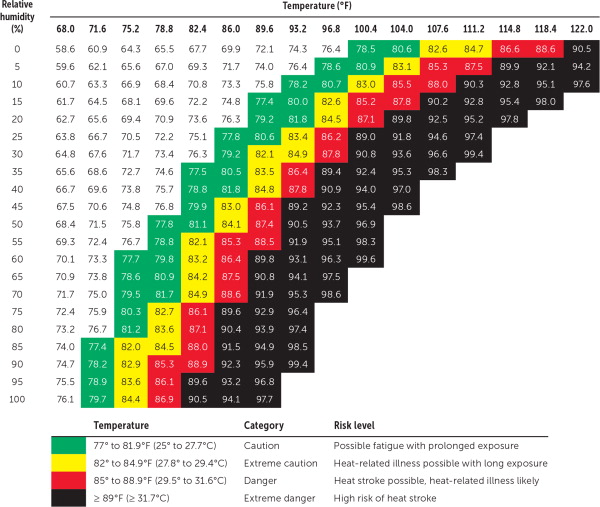You should adjust your pace and your expectations for performance when it’s hot. Included are ways that we measure “hot” and the associated risk for runners.
Air temperature doesn’t tell the whole story. Common sense tells us it’s harder to run when it’s warmer, more humid, in the full sun with no breeze.
What is Heat Illness?
Heat Illness can be categorized by order of increasing severity as dehydration, muscle cramps, heat exhaustion, and heatstroke. All are detrimental to performance and your health, and heatstroke can result in permanent disability or death.
From a physiological point of view, any factor that causes core body temperatures to rise to high levels can lead to decreased performance or heat stress. These factors include physical exertion levels (pace), the duration you run before a break, the duration of the break and your hydration intake, high temperatures, high humidity which decreases evaporation, low sweat levels (dehydration), lack of heat acclimatization, heat-retaining clothing and physical conditions which make certain individuals more susceptible to heat illness.
Why can’t I use the heat index?
The heat index accounts for humidity but does not consider the wind speed, sun angle, or lack of cloud cover—so the heat index tells you how hot it feels sitting in the shade.
WBGT accounts for everything
The WetBulb Globe Temperature (WBGT) is a measure of heat stress which takes all the factors into account: temperature, humidity, wind, and solar radiation.
Unfortunately, these thermometers aren’t easy to tuck into one’s pocket. Because conditions vary from one location to another, a weather station can’t report what the WGBT is for a specific area.
Estimating WGBT
This chart estimates the WGBT using the temperature and relative humidity and assumes full sun exposure. This chart, and it’s accompanying warnings, are applicable to the south. Athletes residing in the northern part of the country are accustomed to cooler temperatures and their warnings occur at lower WBGT.
Preparedness – what to do when the WBGT is high
- pre-hydrate properly (overhydration [hyponatremia] is bad too). Drink 8 to 16 oz of liquid (water or sports drink) one hour prior to exercise
- wear lightweight, light fitting and light-colored clothing
- wear sunscreen (do this even when the WBGT isn’t high)
- plan for 14-21 days for heat acclimatization and your body’s ability to increase sweat production
Suggested Actions and Impact Prevention
- run early or run late to avoid the sun
- SLOW DOWN
- replenish fluids throughout your run
- take breaks in shady areas
- do not attempt personal records when the WBGT is above 77°F for a 5k, 68°F for a 10k, or above 59°F for a marathon.

Pace Adjustments
Most coaches agree when it is warm (that’s anything over 60° with a dewpoint of 50°+) that running based on perceived effort is best. This may be tricky for Floridians as we get so few days to learn what the various efforts should really feel like.
Running coach Mark Hadley published pace adjustments based on Temperature + Dew Point, you can read the full post HERE
Add together air temperature and dew point and see where the combined number places you on the following adjustment chart:
100 or less: no pace adjustment
101 to 110: 0% to 0.5% pace adjustment
111 to 120: 0.5% to 1.0% pace adjustment
121 to 130: 1.0% to 2.0% pace adjustment
131 to 140: 2.0% to 3.0% pace adjustment
141 to 150: 3.0% to 4.5% pace adjustment
151 to 160: 4.5% to 6.0% pace adjustment
161 to 170: 6.0% to 8.0% pace adjustment
171 to 180: 8.0% to 10.0% pace adjustment
Above 180: hard running not recommended
